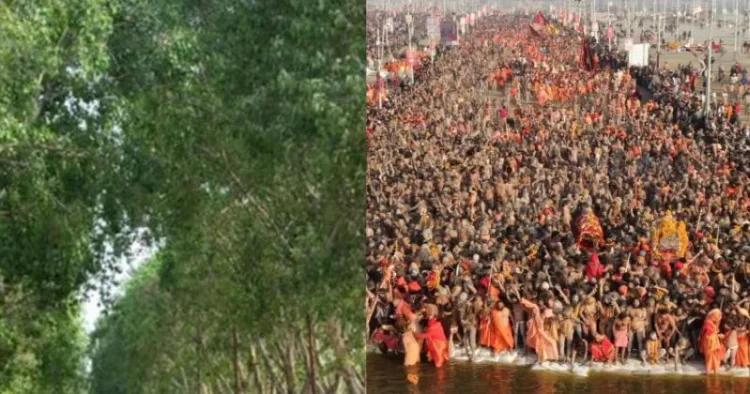Prayagraj: In preparation for Mahakumbh 2025, the Yogi government has taken significant steps to provide a clean and green environment for the millions of devotees expected to visit Prayagraj. Dense forests have been developed at various locations across the city to ensure pure air and a healthy atmosphere.
The Prayagraj Municipal Corporation has utilized the Japanese Miyawaki technique over the past two years to establish multiple oxygen banks, which have now transformed into lush green forests. These efforts have not only enhanced the greenery but also contributed to improving air quality, playing a crucial role in environmental conservation.
Dr NB Singh, former Botany professor at Allahabad Central University and known as the “Greenery Guru,” highlighted the rising pollution and temperatures caused by urbanization. He emphasized that the Miyawaki technique is an excellent solution to these challenges.
According to Dr. Singh, the rapid growth of dense forests using this method helps reduce the temperature difference between day and night during summers. These forests also boost biodiversity, improve soil fertility, and create habitats for animals and birds. Additionally, large forests developed through this technique can lower the temperature by 4 to 7 degrees Celsius, offering significant environmental benefits.
The Prayagraj Municipal Corporation has planted trees at more than 10 locations in the city using the Japanese Miyawaki technique, covering an area of 55,800 square meters over the past two years. In the Naini Industrial Area alone, 1.2 lakh saplings have been planted.
Assistant Engineer Girish Singh explained that this method rapidly develops dense forests. “We planted saplings in the Naini Industrial Area about a year ago, and they have already grown to 10-12 feet tall,” he said. The Miyawaki technique involves planting 3 to 4 saplings per square meter. Industrial waste was removed from the area, and the soil was enriched with sawdust and organic fertilizers to make it suitable for the plants.
Junior Engineer RK Mishra added that these forests have also helped reduce temperatures in the area. “This technique is ideal for developing dense forests even in small spaces. Visitors coming to Mahakumbh can witness these green marvels,” he noted.
The Miyawaki project in Prayagraj began modestly in 2020-21 and has since grown significantly. In 2023-24, the initiative reached a milestone with the plantation of 1,19,700 saplings of 63 species across 34,200 square meters in the Naini Industrial Area’s Nevada Samogar region. This area, once filled with industrial waste and known for its foul odor and unsanitary conditions, has been transformed into a thriving green space.
The city’s largest garbage dumping yard, Buswar, has undergone a remarkable transformation under the Miyawaki project. The site, once filled with waste, was cleaned, and over 9,000 square meters were utilized to plant 27,000 saplings of 27 different species. Today, these saplings have grown into a dense forest, drastically improving the environment.
According to officials, this initiative has not only eliminated foul odors and waste but has also improved air quality and reduced temperatures in the area. Additionally, the Miyawaki technique has been used to create forests at 13 other locations across the city.
The Miyawaki project in Prayagraj is not just about creating forests; it is also aimed at preserving biodiversity and promoting the growth of plants beneficial to the community. The project includes a wide variety of species, ranging from fruit-bearing trees to medicinal and ornamental plants.
Key species planted under the project include mango, mahua, neem, peepal, tamarind, arjuna, teak, tulsi, amla, and ber. Additionally, ornamental and medicinal plants like hibiscus, kadamba, gulmohar, jungle jalebi, bougainvillea, and brahmi have been incorporated. Other species include sheesham, bamboo, kaner (red and yellow), tecoma, kachnar, mahogany, lemon, and drumstick (sahjan).
Understanding Miyawaki Technique
The Miyawaki technique, developed by renowned Japanese botanist Akira Miyawaki in the 1970s, is a revolutionary method for creating dense forests in limited spaces. Often referred to as the “pot plantation method,” it involves planting trees and shrubs close to one another to accelerate their growth. Plants grow 10 times faster with this technique, making it a practical solution for urban areas.
This method mimics natural forests by using a mix of native species planted densely. It improves soil quality, enhances biodiversity, and accelerates forest development. Trees planted using the Miyawaki technique absorb more carbon, grow faster, and support richer biodiversity compared to traditional forests.
In urban settings, this technique has transformed polluted, barren lands into green ecosystems. It has successfully managed industrial waste, reduced dust and foul odors, and curbed air and water pollution. Additionally, it prevents soil erosion and promotes ecological balance, making it an effective tool for environmental restoration.
Version
Prayagraj Municipal Corporation Commissioner Chandra Mohan Garg said that they are creating dense forests in many parts of the city using a special technique called Miyawaki. They have planted 27,000 trees in Baswar after cleaning up the garbage. The largest plantation, with 1.2 lakh trees, is in the Naini industrial area.
This project is not only helping to get rid of industrial waste but is also reducing dust, dirt, and bad smells. Additionally, it’s improving the air quality of the city. Miyawaki forests have many benefits, such as reducing air and water pollution, preventing soil erosion, and increasing biodiversity.



















Comments